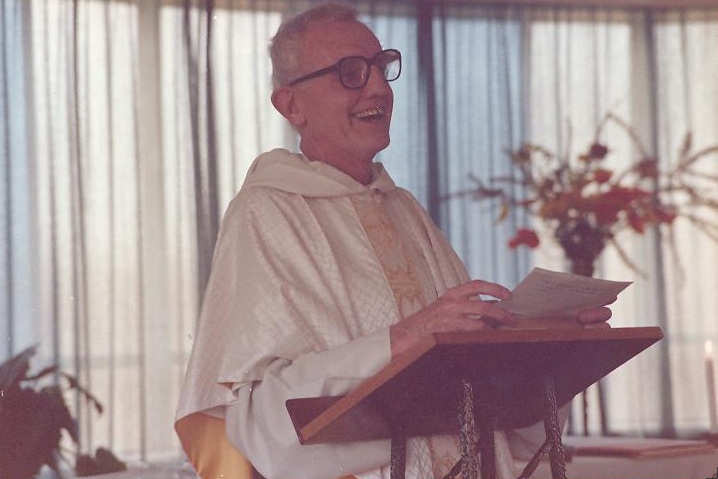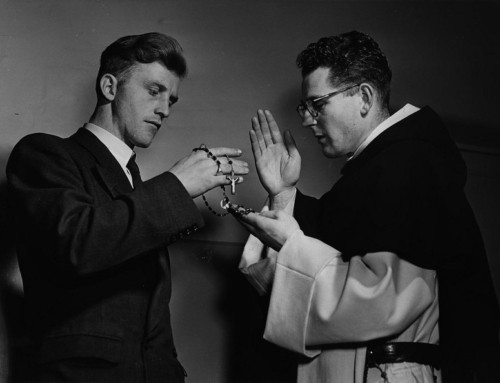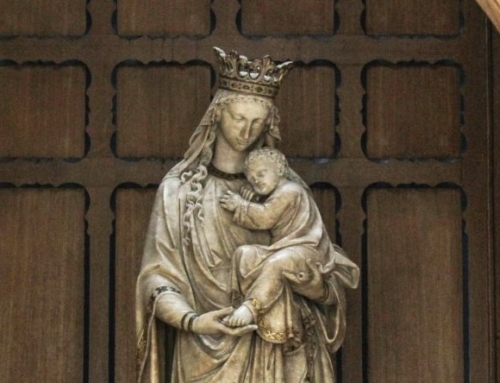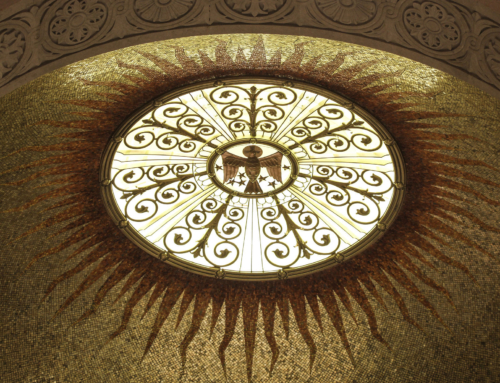Author’s Note
This article concerns the life of Fr. Tom Heath, O.P. (1920-2005), who was a son of the Dominican Province of St. Joseph from his first profession in 1944 until his tragic death in 2005. The uniqueness of his life makes it noteworthy. The value it has, however, is magnified because, on a more fundamental level, it is the life to which each Christian is called: a life yielded over to the power of God’s transformative grace.
To tell this story properly would not have been possible without the aid of many brother friars who had the honor of knowing the man himself. Chief among these is Fr. Kevin Kraft, O.P., who generously shared the fruit of his own research and love of Fr. Tom. My gratitude is also toward my brethren who spoke with me about their relationships with Fr. Tom, including Frs. Benedict Croell, O.P., Gabriel O’Donnell, O.P., Joe Guido, O.P., Peter Batts, O.P., Frank Sutman, O.P., John Corbett, O.P., and Dominic Mutuku, O.P.. Finally, special thanks to Br. Aquinas Beale, O.P., whose idea this project initially was, and who encouraged me to see it through to completion.
Introduction
Give and gifts will be given to you; a good measure, packed together, shaken down, and overflowing, will be poured into your lap. For the measure with which you measure will in return be measured out to you. –Luke 6:38
…I wanted to linger on it, to be saturated with the work of this brother who had painted on those walls five hundred years ago. The serenity, the purity of intention, the sheer goodness, innocence, and above all, the joy, overwhelmed me, [how Fra Angelico] living in a period of turmoil, could create his little islands of beauty and truth for others, if he could accomplish that and still remain a faithful, even holy Dominican, then perhaps there was some hope for me…
–Fr. Tom Heath, O.P. recalling in his travel journal a visit on June 4, 1958 to San Marco, a Dominican residence in Florence, Italy which in the 15th century was home to the famous painter and Dominican, Fra Angelico.
In the summer of 1958, Fr. Tom Heath, O.P. was searching for some hope. Just sixteen months before, his life and ministry had a clear direction. Ordained a priest in 1950, he had just concluded six years as a beloved professor at Trinity College, a women’s school next to the Dominican House of Studies where he lived in Washington, D.C. In 1956, he had earned a Ph.D. in Philosophy from the Catholic University of America. With that degree, he set sail in January 1957 with a few fellow friars on a missionary venture to Beirut, Lebanon, their purpose being to found a university. The mission, however, seemed doomed to fail from the beginning. There was a lack of coordination in the mission, as well as horrific acts of terrorism that brought the young priest face to face with evil. At the end of May 1958, Fr. Tom and the other friars closed down the mission after just over a year. He described his feelings at the time as a mix of disappointment, bitterness, and heartbreak.
In light, then, of the turmoil that was going on in Fr. Tom’s religious life, his experience at San Marco described above was a moment of extraordinary grace. Moreover, it seems fitting to call this event a strengthening of the heart, given what the Lord would be calling him to in the remainder of his priestly ministry. For in Fr. Thomas Richard Heath, we meet a friar who would be called to teach the laity, to teach religious theology in the midst of the Second Vatican Council, to form his province’s novices during the upheavals of the 1970s, to go to Africa at age sixty, to become a parish priest for the first time at age sixty-six in apartheid South Africa, to become the first superior of the newly formed mission in Kenya at age seventy-one, to suffer the effects of a stroke in his last years, and to ultimately die at age eighty-four as a result of an assault he sustained in a robbery.
The truly remarkable thing, however, is that the words he uses to describe the atmosphere inside the Florentine convent—serene, pure, good, innocent, joyful—are all words that would come to be used to describe him by those who knew this holy man. It is as if he himself—being formed by the Word he studied, contemplated, loved, and preached—became a light, a “little island of beauty and truth” for all those who encountered him during his Dominican life.
A friar of our Province, Fr. Kevin Kraft, has put together a book-length biography of Fr. Tom’s life. For the purposes of this essay, however, we shall endeavor to chart a more modest course. Let us seek to understand this man better through the five adjectives he used to describe his experience at San Marco. In so doing, we can begin to sketch contours of a life lived in the zealous pursuit of sanctity, stoked by the flames of faith, hope, and charity.
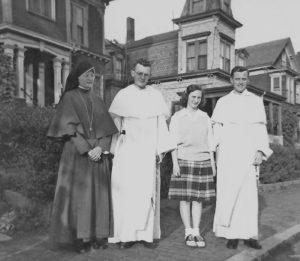
A young Fr. Tom (L) with his sisters Leslie (R) and Mary (a Maryknoll Missionary Sister), and one of his brothers, Fr. Walter Heath, O.P.
Serenity
Upon returning to the United States in 1958 after his time in Lebanon, Fr. Tom accepted a position teaching theology at St. Mary’s College in Notre Dame, Indiana. These were happy years, years in which teaching and chaplaincy gave Fr. Tom a renewed mission after his disappointing missionary experience. Fr. Tom wrote that he drew inspiration in these years from this reflection Pope St. John XXIII offers in the concluding pages of his encyclical Pacem in Terris: “Every believer in this world of ours must be a spark of light, a center of love, a vivifying leaven amidst his fellow men. And he will be this all the more perfectly the more closely he lives in communion with God in the intimacy of his own soul.” Fr. Tom found great wisdom in these lines, commenting on them in his own book, In the Face of Anguish, which he published in 1966. He wrote, “After outlining so many great projects for the Christian, he came full circle back to the source of all strength and power, man’s own personal communion with God. Without that there simply cannot be Christian courage or Christian action” (182).
As befits a son of St. Dominic, Fr. Heath did not content himself merely with the study of the Pope’s words. He contemplated them, and then he tried to pass on the fruits of his contemplation to his students. Perhaps from his own experience of personal turmoil a few years before, he knew that fostering such a relationship with God could benefit his students as they tried to navigate the anxieties of their college years. Their uncertainty was compounded by the social upheavals taking place in the 1960s. For them, Fr. Tom’s serene disposition was a calming and stabilizing presence. One former student recounted her chaplain and professor’s impact particularly on female college students in an alumni magazine article published upon his death. It is striking how fondly he is remembered, even four decades later: “As a beloved chaplain at St. Mary’s during the 1960s, Father Heath touched many of us with his unpretentious, down-to-earth manner and his compassionate and caring way. It was a time of much change in the Church and in the world. Father Heath helped provide a steady and common sense approach to young women for whom the foundation on which they had planned to build their lives seemed shaken and vulnerable.”
In 1965, Fr. Tom moved on from St. Mary’s to teach his brethren at the Dominican House of Studies in Washington, D.C. These were trying times. In the aftermath of the Second Vatican Council, there were differences of opinion in the seminary about whether the theology of St. Thomas Aquinas should still be taught as the foundation of priestly education. During these years, Fr. Tom heard complaints from some seminarians about the uselessness of lectures, antiquated thinking stifling their studies, and a host of other concerns.
Through it all, Fr. Tom persevered in teaching the Angelic Doctor, even contributing two volumes (35 & 51) in a sixty-one volume set of St. Thomas’s most famous and important work, the Summa Theologiae, edited by fellow Dominican Fr. Thomas Gilby. A journal entry from November 8, 1968 gives an insight into his indefatigable serenity amidst a chaotic period: “A delicious moment a while ago. Late afternoon, dusk, a cool, almost cold draft of air in the room from an open window, lights of cars streaming by on Michigan Avenue: the CU [Catholic University] chimes playing Ave Regina Caelorum. I was cast back into the Middle Ages: St. Thomas and Paris, and the cathedrals, and the goodness of men, and love and joy, and peace. A small look on heaven.”
Purity
While Fr. Tom was convinced of the necessity and fruitfulness of teaching the perennial truths of the faith in the classroom, he also was profoundly moved by the spirit of many Christians who at that time had newly devoted themselves to causes of justice and peace. Reading his description of this period of his life, one catches a glimpse of a man seeking to follow Christ in a new way: through direct interaction with the poor and marginalized. In his heart, he felt a pull to know those in the black community in Washington in a more intimate, Christ-like way. Finding that the House of Studies was too institutional of a place for this sort of encounter, he and several other friars began considering moving to a house a few blocks away, where they would operate a legal aid office as well as a meeting and prayer space for the people of the neighborhood. They spent the last months of 1966 discerning the feasibility of such a project, even traveling to New York City to seek the counsel of Dorothy Day, the social activist and founder of the Catholic Worker Movement, whose cause for canonization is now open. She gave them her enthusiastic endorsement.
In February 1967, Fr. Tom and another priest moved into 123 11th Street, which became known as the “123 House”. By June, there were five friars in residence. “All of us,” Fr. Tom writes in reflection years later, “in one way or another felt that we had finally been able to concretize a commitment—the gospel’s commitment—to the poor, that our love for our black brothers and sisters was not just talk but had something visible and tangible behind it.” He had sought after and found a way to answer the call to go out and meet the poor and disenfranchised in his community.
All the while that Fr. Tom lived at the 123 House, he still kept teaching at the House of Studies. After about a year and a half, the frenetic pace of his life had taken a toll. It was common for him to rise at dawn and not go to bed until 2:00 or 3:00 in the morning. Exhausted by the daily labor, his life in the dual apostolates of social activism and teaching had left little space in his schedule for prayer, fraternity with other friars, and preparing his lectures. The time had come once again to purify his Dominican life, to prune the branch in order to save the tree. He writes, “I…came to the decision to leave 123, to return to the House of Studies, to teach better, to preach frequently in the white suburbs on the issues that I now knew more about and could speak on with a new authority. I knew I would look less relevant, less authentic, but that actually I would be doing what I could do.”
Fr. Tom was the only priest of those who lived at 123 to return to the conventual life at the House of Studies. He was also the only one who did not leave the Order in the turbulent years that followed. It is a testament to the purity of his life that he was able to discern what was truly at the heart—what was the essence—of his consecrated life. Very soon, he would be asked to share that knowledge with his younger brethren in a new role.
Goodness
In 1974, Fr. Tom took over as Novice Master, moving to the novitiate in Dover, Massachusetts. He had been interviewed by the Provincial Council for the same position in 1972. In a reflection years later, he recalls that on the flight to the interview, he had come up with a few reasons why he would not be a good choice. Among these were his age (he was fifty-two at the time), his impracticality, and his lack of popularity with the student brothers in Washington. The Council decided at that time on another friar for the post, but Fr. Tom was asked to accept the position when it once again became vacant two years later.
Friars who were assigned to Dover in those years speak of the goodness of the man: what he admittedly lacked as a practical administrator, he made up for in his gentleness and concern for the brothers as individuals. More than one characterized him as a mystic of sorts: he saw things on a different plane than what was objectively perceptible. Fr. Tom once wrote that his happiest moments were when he was privileged to be a witness to moments of grace in the life of a young friar: “A novice would say something quite innocently, not realizing it was revealing the depths of goodness in his soul, or another who had been thinking about leaving and praying about it would come in and tell me he had realized that his whole happiness lay in preaching the gospel.”
One friar remembers an occasion when Fr. Tom, knowing he loved poetry, delivered him a hand-written poem composed on a yellow sheet torn off of a legal pad about confession. The first line betrays the gentleness and pastoral heart of its author: “My heart is pierced by gentle things, / caught in cruel circumstances.” In another place, Fr. Tom’s own description of his joy as Novice Master conveys the warmth and goodness with which he lived:
What I liked to do most was talk to them, not as a group, but individually, about our life, about good Dominicans I knew, good books I had read by or about Dominicans, or just any good books, novels, poetry, biographies. And I would listen to them talk about their families, their spiritual journeys, so to speak, what they were currently reading, their hopes. I would encourage them to write, to pray, or forgive, or to understand other novices whose views they could never share. Many times after such interviews I would stand at the window looking out at the trees in the distance, smoking my pipe, realizing that no one could ever be happier.
Innocence
Part of the attractiveness of Fr. Tom’s life is its innocence: he was a trusting, obedient son of the Order and of the Lord’s mysterious will. In 1972, he had questioned his suitability for the role of Novice Master because he was fifty-two years old. Now in 1979, with Fr. Tom nearing his sixtieth birthday, his Provincial asked if he would be willing to go to Lesotho, a small country in the middle of apartheid South Africa, to be a mentor in the novitiate community there that was looking for help.
At first he hesitated. Upon the completion of his duties as Novice Master, he had hoped to return to teaching in Washington, where his biological brother Mark (one of two other Heath brothers in the Order) was living. There was also, one would imagine, some trepidation due to his past failure as a missionary in Lebanon. After some thought, however, he abandoned himself with joy to God’s will. Of this decision, he writes, “I really wanted to come to Africa. The excitement that began in my heart then… was simply wonderful. I was a young priest again, going on the missions. Everything that was latent in my romantic and missionary heart was set on fire.”
In 1986, after six years spent teaching the novices in Lesotho as well as children at a local high school, Fr. Tom was asked once again to consent to a new apostolate. At age sixty-six, he was, for the first time in his priesthood, asked to be a parish priest. In this new ministry, Fr. Tom was a shepherd to both black and white South Africans, attempting to unite them in an awareness of what they really were: the one Body of Christ. His holy meekness and innocence is almost palpable in this reflection from a parishioner: “He loved quoting poetry but tended to dissolve into tears halfway. He was a gentle shepherd… It was this gift of celebrating every experience God sent him as if it were of the utmost importance at that moment that made this very humble and poverty-loving priest a great one.”
As Fr. Tom entered into his eighth decade of life, one could reasonably assume that dramatic changes were over for this elderly priest. He had settled into his role as pastor and was content and happy there. But there was one final move remaining. After having spent over a decade in South Africa, Fr. Tom’s Provincial asked him to go to assist his brethren in the founding of a new mission in East Africa. It was to be on Kenyan soil that the final scene of this wonderful life was to be acted out.
Joy
Fr. Tom arrived in Nairobi, Kenya in April 1991. A month later, he was elected as the first Vicar Provincial of the new mission. He led the Vicariate through its first year, raising funds and securing housing for the foundation. This administrative work was grueling for him, however, and in June 1992 he decided to step down in order to return to teaching at the national diocesan seminary. He also formed a friendship with a community of Franciscan sisters nearby, for whom he would celebrate Mass several times a week. One sister recalls that he made it a point to be present each year on “clothing day”, when the new novices would receive their habit and their religious name. From that day forward, he would remember each of their names, a sign of his love and concern for them.
These final years were in many ways the crown of a life formed and transformed by the Order and the Word of God. Friars present with him in Kenya recall that his joy and fulfillment was evident, even as his body and memory began to deteriorate. In a 1998 newsletter, he told family and friends that he didn’t have plenty of “pep” anymore, but he had “enough to keep teaching and preaching almost every day, and reading a lot for new courses, and loving life.” One friar assigned with him at the novitiate in Kisumu recalls how in the evenings Fr. Tom would be in his room, either studying or praying under a single light bulb that hung from the ceiling. His door was always ajar, so as to be available to the other friars who might want to seek his counsel or go to confession. His self-deprecating humor and generosity was a model for the friar novices with whom he lived. He was also beloved in the town, where both Christians and Muslims alike knew him as “the joyful priest.”
Fr. Tom came to love Kenya in a way different from all his other postings. In a 1998 correspondence with his superior, Fr. Tom showed his joy and happiness in the mission through his request to someday be buried in Africa. He writes, “On the subject of where I want to be buried, my desire is to die and be buried here in Kenya, in Kisumu, on our property across the road from the novitiate, what Kieran [another priest in the mission] calls the Orange Grove.” Several years later, Fr. Tom desire would be realized, albeit through tragedy. On the evening of January 4, 2005, the novitiate house was invaded by a band of robbers. Several men held the friars at bay with AK-47s and machetes, while others went around looking for valuables to take. In the midst of the looting, Fr. Tom was cut on the arm by the blade of a weapon and was subjected to severe blows to his elderly body. In the days that followed, the eighty-four-year-old developed pneumonia and suffered internal bleeding in his abdomen as a result of the injuries he had sustained.
Several days later, on the evening of January 13, the Lord called Fr. Tom to his eternal rest. The Vicar Provincial at the time wrote this moving commemoration of his fallen brother to the members of the Province on the day after his death. It is a testament to a life lived out in joy:
Tom really surprised us, for one last time. This morning we celebrated MP [Morning Prayer] and Eucharist, missing his voice in the third psalm, ‘Cry out with joy to the Lord, all the earth, serve the Lord with gladness,’ which he always belted out with relish. How we will miss him! Tom has been a pillar of the Vicariate from the very beginning… Comparisons are odious, but there is no doubt that Tom was the most beloved of all the Brothers in the Vicariate. Young Brothers rallied around him and felt comfortable with him, while the Elders found in him the wisest of counselors.
Postscript
On January 17, 2005, a Mass of Christian burial was celebrated for the repose of the soul of Fr. Tom. An enormous gathering of friars, sisters, Christians, and Muslims came to pay their respects to the life of this holy man, a man whose life came to resemble those masterpieces made by his elder brother Fra Angelico. Christ himself had crafted a masterpiece out of this poor friar’s existence, a life that manifested the serenity, purity of intention, sheer goodness, innocence, and, above all, the joy of knowing the Lord and doing his will.
Fr. Tom is buried where he had wished to be, in the garden across the road from the novitiate in Kisumu. His grave is beside a lemon tree, which he had planted on the day the novitiate was dedicated. Some months after his death, Fr. Tom’s name was included in the “Martyrology of the Contemporary Church,” published by the Congregation for the Evangelization of Peoples as a testament to those who have given their lives as part of their witness to the faith. In 2009, a friar of our Province who lived in Kenya at the end of Fr. Tom’s life, Fr. Andrew Hofer, wrote a poem, “For a martyr of the contemporary Church”, dedicated to the memory of Fr. Tom:
Lala salama.
“Rest in peace,” in Swahili’s song
still echoes in my ears.
This lullaby, like the lemon tree,
hovers over the missionary’s grave.
Sisters sing to their dead beloved—
priest, poet, teacher, friend—
as if rocking a child to sleep.
Brothers shovel over earth’s wound
with faith in the Seed, the one Seed,
that bears much fruit.
In face of anguish, he held the Ancient of Days
as the Virgin’s child.
The old was made young in joyful mystery—
charity’s effect.
The new Simeon witnessed the marvel.
His feet then walked in peace
towards a foreign land he glimpsed
where martyrs beat drums, virgins dance,
and dreams unfold like rose petals
for the Master’s endless glory.
Lala salama.
✠
Image: Fr. Tom Heath, O.P.
Download a PDF of this article HERE

